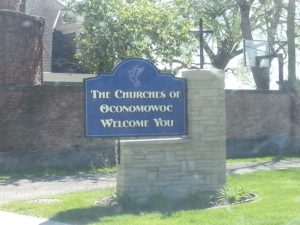 OCONOMOWOC, Wisc. — A prominent professing atheist group is seeking the removal of a Wisconsin city’s welcome signs because of their religious content.
OCONOMOWOC, Wisc. — A prominent professing atheist group is seeking the removal of a Wisconsin city’s welcome signs because of their religious content.
The Freedom From Religion Foundation (FFRF) recently sent a letter to the mayor of Oconomowoc after being notified by a local resident that the city has two signs on public property that read, “The Churches of Oconomowoc Welcome You.” A cross rests on the same structure that holds the sign.
“Displaying signs that promote Oconomowoc’s Christian churches, along with Latin crosses, fails to respect [the] constitutional mandate of neutrality,” it wrote. “It endorses religion over nonreligion and Christianity over all faiths.”
FFRF said that contrary to the message of the signs, unbelievers will feel unwelcome.
“These signs convey a message to non-Christians in Oconomowoc that they are not ‘favored members of the political community,'” it asserted. “These citizens should not be made to feel excluded, like outsiders in their own community, because their city prominently places Christian symbols and and promotes Christian churches on city property.”
The group asked that the signs be removed from city property.
However, the Wisconsin Institute for Law and Liberty soon pushed back by also writing a letter to Mayor David Nold, refuting FFRF’s belief that the signs violate the Establishment Clause of the U.S. Constitution.
“[I]t is not unconstitutional to acknowledge the historical role that religion has played in this country. There are many organizations and communities that have made Oconomowoc the vibrant place that it is. One is its ‘churches’ and it is not wrong to acknowledge that,” it wrote.
The Institute noted that private parties paid for and maintain the signs, and that the welcome on the signs excludes no one.
“The signs welcome everyone to the City of Oconomowoc. There is absolutely nothing wrong with the churches of Oconomowoc (or the Rotary, or the Lions, or the Kiwanis) welcoming people to the city. No one would argue that
people who are not associated with the Rotary or the Lions or the Kiwanis would feel unwelcome in the City because of their signs,” it said.
The legal organization also pointed out that that as religious drawings are even on display at the nation’s highest court, there is no mandate to purge religion from everything pertaining to the government.
“Contrary to what the FFRF would have you believe, there is no absolute prohibition on religious symbols in public places,” it wrote. “The building where the United States Supreme Court, itself, is housed contains paintings of Moses and the Ten Commandments. If the FFRF was correct, then it would be necessary for all such religious symbols to be removed from government property, but that is not the law.”
The city states that it is investigating, but has not yet indicated one way or the other its position on the matter.
As previously reported, the 2005 U.S. Supreme Court decision of Van Orden v. Perry, which upheld a Ten Commandments monument at the Texas state capitol, noted that religious displays may be found in a number of government buildings.
“For example, a large statue of Moses holding the Ten Commandments, alongside a statue of the Apostle Paul, has overlooked the rotunda of the Library of Congress’ Jefferson Building since 1897,” it wrote. “And the Jefferson Building’s Great Reading Room contains a sculpture of a woman beside the Ten Commandments with a quote above her from the Old Testament (Micah 6:8).”
“A medallion with two tablets depicting the Ten Commandments decorates the floor of the national archives,” the court outlined. “Inside the Department of Justice, a statue entitled ‘The Spirit of Law; has two tablets representing the Ten Commandments lying at its feet. In front of the Ronald Reagan Building is another sculpture that includes a depiction of the Ten Commandments.”
Become a Christian News Network Supporter...


